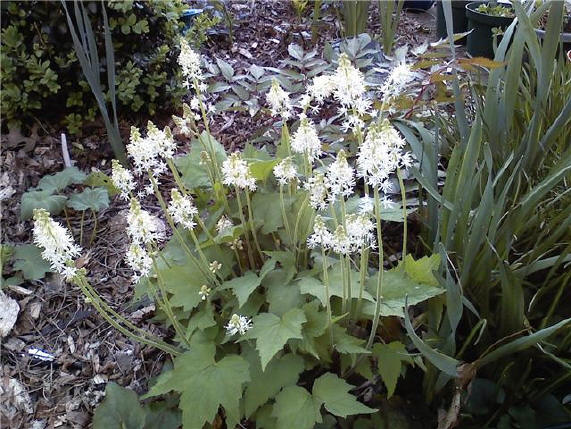|
Cottage Gardens - the Anything Goes Garden
Melissa L. Metcalf
Adams County Master Gardener
 The phrase cottage garden brings many different pictures to ones' mind.
Some people will visualize vast areas of overflowing flowering gardens, while others think of small, tucked away spaces. Cottage gardens have their roots in the English Tudor
period where the average person had to rely on their own dooryards and growing skills for the very day-to-day needs to keep their families alive. Nowadays, cottage gardens
are a place to rest and relax and remember plants from Grandmother's garden, all while serving a very important purpose. The phrase cottage garden brings many different pictures to ones' mind.
Some people will visualize vast areas of overflowing flowering gardens, while others think of small, tucked away spaces. Cottage gardens have their roots in the English Tudor
period where the average person had to rely on their own dooryards and growing skills for the very day-to-day needs to keep their families alive. Nowadays, cottage gardens
are a place to rest and relax and remember plants from Grandmother's garden, all while serving a very important purpose.
A cottage garden has no required designs, but is a mix of practical plants such as vegetables, herbs and fruits, alongside flowers for
decorative purposes. Flowers are also included in a traditional cottage garden to help lure pollinators to increase the yield of produce from your plants. This type of garden
can provide food and medicines, as well as bring color and beauty into the home.
For those who have an aversion to weeding, you may find the styles of cottage gardening to be a pleasure. In most gardens, the plants are so
closely grown together; there is little room for weeds to take root. Also, a heavily applied layer of organic mulch will help. Hardy, very tolerant plants are the ones that
usually survive in these gardens, as fussy plants will soon be overwhelmed by others that do not need as much care.
Cottage gardens have a very carefree and unplanned look to them, although they do take a bit of time when you first lay them out. As for any
other garden, you want to look as to what your garden area offers by way of soil type, watering requirements and how much sun or shade it receives during each growing season.
While you are dreaming about which plant will go where, you will want to incorporate vertical accents, along with any seating areas that you may want. Also, when scheming
where your plants will go, keep in mind how your garden will be viewed each season, so taller plants don't always overshadow shorter plants and the shorter varieties don't
get overwhelmed by their taller friends and that there is always something visually interesting to view.
When actually getting around to installing your garden, start off with the hardscapes such as walkways, trellises or raised beds, and then
plant your small trees and shrubs next. Some ideas for these might be dwarf fruit trees, crape myrtles or a redbud or two. All of these will provide filtered shade, as well
as structure to the garden in the wintertime. You can't possibly have a cottage garden without a rose or two, so add a climber, bush or groundcover one!
After you have decided where the backbones of your garden will lay, start adding in taller perennial plants and vines. This is a really good
place to stop and decide if you are wanting your cottage garden be a mix of type of plants, or go with a theme such as heirlooms, natives, or a single colored-theme garden.
Most of the perennials that you will end up with will be ones that are hardy, easy to share or trade and easily propagated; plants that require a lot of specialized care,
generally do not thrive in a cottage garden environment. Some of the most common perennials found in cottage gardens might include columbine, lavender, poppies, irises,
foxglove, hollyhocks and daisies. Smaller plants such as geraniums, violets, pansies and thymes do well interspersed among larger plants. Vines such as clematis, hops and
trumpet creeper will give the option of height in the garden. Keep in mind plantsí textures and scents when giving them their new homes.

Annuals play a large role in cottage gardens. These plants are generally inexpensive and easy to acquire or grow yourself; a lot will reseed
themselves, too. The first year or two of a garden's life isn't going to be lush and filled in, and this is where annuals will play their biggest roles. Since annuals come in
all shapes, sizes and colors, they can be tucked around your garden, to give the effect of a more mature planting. This is also a great way to try out different color and
height combinations, as well as leaf and flower textures and scents.
Cottage gardens, although generally smaller in nature, can be acres of separate rooms or as small as a few well-placed containers.
Financially, these gardens can cover a very broad spectrum. Some gardens will be designed and come alive that will cost thousands of dollars, whereas others may be completely
made up of shared and traded plants and other garden finds; the sky is the limit!
There are a lot of different garden styles out there, but you can truly call yours a cottage garden if it is informal, includes a variety of
herbs, vegetables and flowers mixed together, and provides you a relaxing and happy atmosphere. Happy gardening!
Read other articles on garden and landscape design
|